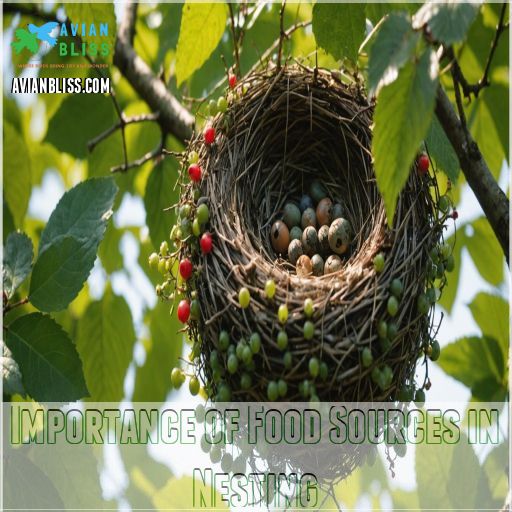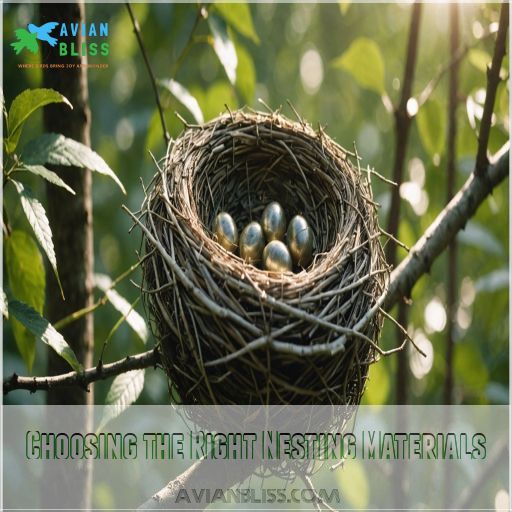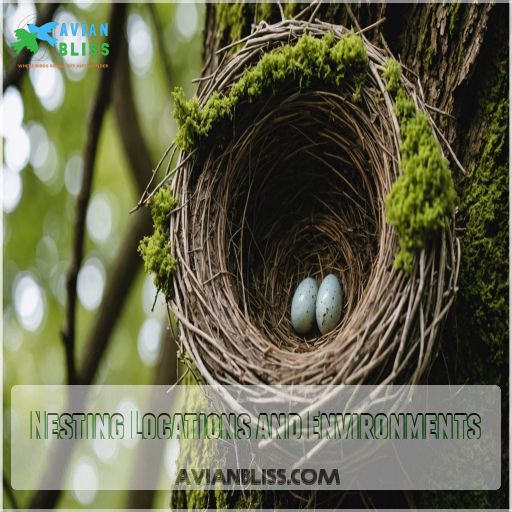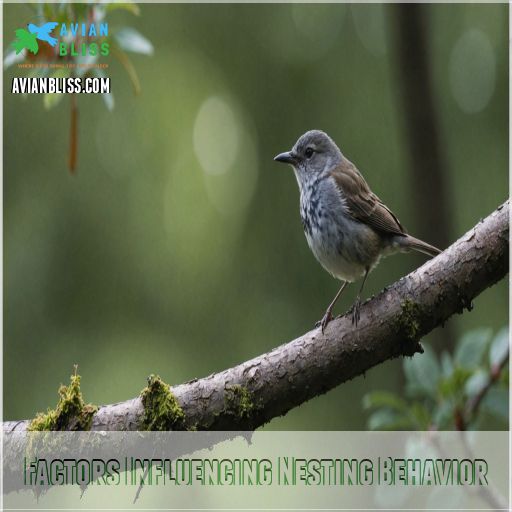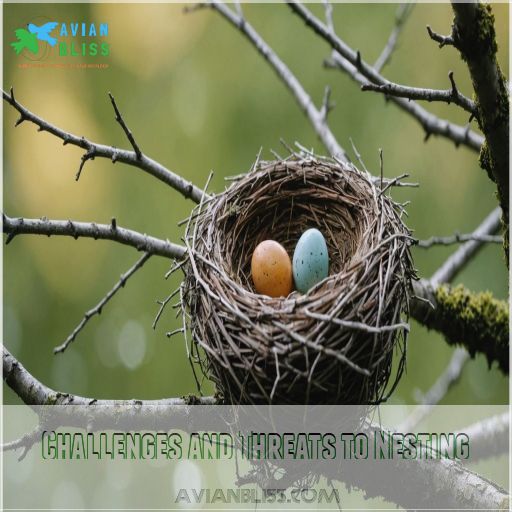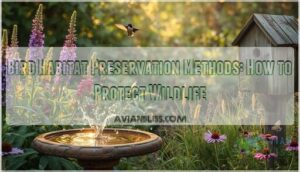This site is supported by our readers. We may earn a commission, at no cost to you, if you purchase through links.
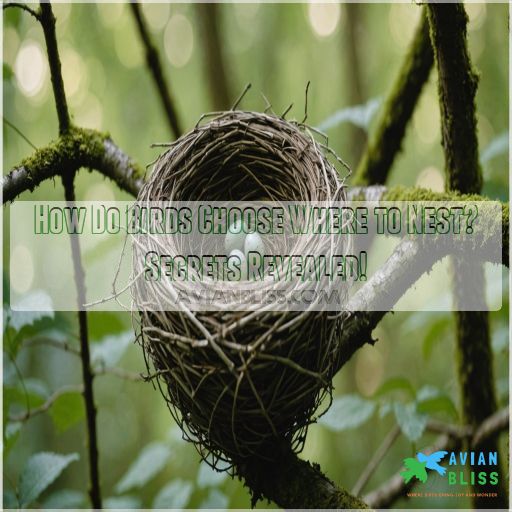
They prioritize safety, comfort, and convenience, looking for sites that provide shelter and camouflage to hide from predators.
Proximity to abundant food sources, like water and insect hotspots, is a must-have to make sure their chicks grow strong.
Temperature regulation is key, too—it’s all about finding that Goldilocks zone: not too hot, not too cold.
Birds often prefer locations that limit access to them, and nest materials also play a role—plenty of local twigs and leaves seal the deal.
Curious about their crafty building tactics? Stay tuned!
Table Of Contents
- Key Takeaways
- Key Nesting Site Selection Factors
- Importance of Food Sources in Nesting
- Choosing the Right Nesting Materials
- Nesting Locations and Environments
- Factors Influencing Nesting Behavior
- Nesting Habits and Diversity
- Challenges and Threats to Nesting
- Conservation and Protection Efforts
- Understanding Bird Nesting Behavior
- Frequently Asked Questions (FAQs)
- How do birds choose a nest location?
- Should you have birds nesting in your area?
- Where do birds build their nests?
- What are the patterns of bird nesting locations?
- How do birds pick a spot to nest?
- What does it mean when birds make nests around your house?
- How do birds know where to nest?
- Do birds always nest in the same place?
- How is nest protection regulated legally in Canada?
- What permits are required to remove bird nests?
- Are inactive nests protected by the MBTA?
- How can I legally discourage birds nesting?
- How does nesting impact bird conservation status?
- Conclusion
Key Takeaways
- Birds are like savvy real estate agents when picking nest locations; they prioritize safety from predators, accessibility to food sources, and a comfortable microclimate. Imagine them with little checklists, seeking tree nooks or shrub hideaways that keep their chicks snug and secure.
- Nest materials aren’t just random picks; birds are DIY experts, selecting the perfect twigs and fibers for durability and comfort. Some even ingeniously use man-made materials like string, channeling their inner decorators to make a cozy crib for their future chicks.
- Climate and environment matter in birdhouse shopping trips; birds adapt to changing weather and local conditions, using their keen instincts and learned behaviors to select sites with the best balance of shelter, warmth, and access to nest materials.
- Human activities can put a dent in birds’ nesting plans, but you can help by offering bird-friendly environments. Whether it’s installing birdhouses, avoiding pesticides, or joining community conservation efforts, every bit counts in safeguarding the future homes of our feathered friends.
Key Nesting Site Selection Factors
When birds choose a nest site, they’re like homebuyers hunting for the perfect blend of safety, comfort, and convenience.
From cozy tree alcoves to handy snack bars, you’ll find that their priorities—shelter from predators, easy food access, perfect temperatures, and crafty nest-building materials—aren’t so different from ours.
Shelter and Concealment From Predators
When choosing nesting sites, birds aren’t just “winging it” against predators.
They cleverly select spots that offer:
- Natural shelters like chimneys or vents
- Hidden locations to enhance nest camouflage
- Concealed sites ensuring nest security
- Ideal structures reducing bird nest threats
These habits reflect instinctive wisdom, turning every nook into a fortress.
Proximity to Abundant Food Sources
Savvy birds know that nesting near abundant food sources is key to raising healthy chicks.
This strategic placement boosts reproductive success and gives nestlings the best start in life.
Proximity to insect populations, fruit trees, and other reliable food options helps parents efficiently forage and feed their young , which is crucial for raising healthy chicks.
Temperature Regulation and Microclimate
Birds are like seasoned travelers, always ready with a thermal blanket when choosing their nesting hotels.
Selecting a site with the best temperature regulation is like finding that coveted shady spot during a sunny picnic.
Nest insulation and microclimate impacts help keep chicks cozy, ensuring they don’t experience heat stress or struggle with cold tolerance.
Predator Avoidance Strategies
Ever wondered how birds outsmart predators while nesting? They’ve got tricks up their feathers!
From choosing nest sites at different heights to using clever camouflage techniques, birds employ ingenious strategies:
- Nest site height can deter ground predators.
- Camouflage techniques blend nests into surroundings.
- Group defense provides safety in numbers.
- Nest design can be tricky!
- Predator alarm calls warn of danger.
Birds are true avian architects! .
Availability of Suitable Nesting Materials
So, what’s the real estate mantra for birds? Location, materials, materials! After dodging predators, they need the right stuff for nest evolution.
Leaves, twigs, and mud, though sometimes innovative materials like spider silk or moss work wonders . Bird nest construction often mirrors human impacts; avoid synthetic fibers and offer natural fibers instead!
Importance of Food Sources in Nesting
When birds choose their nesting spots, they’re not just looking for a cozy nook; they’re also scouting for nearby buffets of mouthwatering meals.
Like weary parents seeking takeout, birds often settle near attracting insect-eating birds attracting insect-eating birds and buzzing insect hotspots to make sure their chicks don’t go hungry
.
Nesting Locations Near Water Sources
When choosing a nesting site, many birds, like fish-eaters and waterfowl, prefer spaces near water sources such as riversides or coastal and wetland habitats.
This proximity offers a reliable supply of food—whether it’s fish or plants—and a cool microclimate (Source).
It’s like picking a home with built-in air conditioning and a buffet right outside the door!
Proximity to Insect Populations and Fruit Trees
Imagine birds nearby water, seeking every juicy bug and ripe fruit to support their growing families.
Birds are influenced by water in several ways, as it plays a significant role in their lives. It:
- Insect Abundance: Provides nourishment.
- Fruiting Season: Aligns with nesting.
- Food Availability: Makes their survival possible.
- Bird Diet: Influences placement.
- Balance: Makes for happy chicks.
Birds are picky eaters, just like us during holidays!
Diverse Food Options for Reproductive Success
Birds that have access to a diverse array of food sources, from insects to fruit, are more likely to experience reproductive success.
By nesting near these abundant food sources, birds can efficiently gather the nutrients needed to produce healthy eggs and feed their hungry chicks.
This food-rich environment sets the stage for thriving bird populations.
Food Availability During Chick-Rearing Stage
A key element in chick rearing is food availability, as it directly impacts chick growth and nestling survival.
Birds often nest near rich food sources, ensuring efficient feeding strategies.
Parental effort spikes during this time as they juggle between finding food and protecting their young, ensuring their fledglings grow strong enough to leave the nest.
Choosing the Right Nesting Materials
When birds are on the hunt for nesting materials, they show an impressive knack for choosing the perfect twigs and fibers.
Sometimes they even grab string or paper from our backyards.
It’s like they’re tiny, industrious decorators taking advantage of nature and human leftovers to craft cozy cribs for their future chicks.
Types of Natural Materials Used in Nesting
Nesting allows birds to safely rear their young while balancing food access and material practicality.
They cleverly construct nests using:
- Twigs and leaves: These provide structure and camouflage.
- Moss and feathers: Offer insulation and comfort.
- Mud and grass clippings: Stick it all together like a nature-made adhesive.
It’s like your garden’s becoming a construction site!
Use of Man-Made Materials in Nest Construction
Birds, ever the resourceful builders, often incorporate man-made materials into their nests. While plastic might give a nest a modern twist, it’s really a safety blanket for their nestlings, offering insulation and structural support—though at a risky cost.
Here’s a snapshot of materials birds cleverly use:
| Material | Purpose | Impact |
|---|---|---|
| Plastic Strips | Insulation | Harmful |
| Cigarette Butts | Parasite Deterrence | Controversial |
| Fishing Nets | Structural Support | Dangerous |
| Baler Twine | Nest Building | Hazardous |
Collection Process and Resourcefulness
Imagine birds as master architects, sourcing sticks and leaves and creatively using odd finds like feathers and webs.
They’re like DIY enthusiasts rummaging through a mystical hardware store, blending natural and man-made materials to craft nests as marvelous mix-and-match homes .
It’s an architecture tale of ingenuity and resourcefulness, feathered pros in nesting material adaptations!
Adaptation to Local Environment and Material Availability
Choosing the right nesting materials is a bit like finding the perfect blend of comfort and strength for a cozy home.
Birds cleverly adapt to their environment by using available resources, blending natural and innovative materials like twigs or moss to meet their needs.
It’s all about finding what works locally and efficiently, which is often achieved through using resources such as available resources.
Nesting Locations and Environments
When it comes to choosing the perfect nesting spot, birds are true masters of their craft.
From cozy tree cavities to perched platforms on towering cliffs, the options are endless – and birds know just where to look to keep their little ones safe and sound.
Trees and Shrubs as Ideal Nesting Sites
Finding the right nesting spot is a bit like choosing a cozy hideaway.
Consider trees and shrubs with dense canopies and varied heights, as they provide:
- Nesting concealment: Out of sight, out of predators’ minds.
- Branch strength: Reliable branches prevent home collapse.
- Predator access: Limited pathways protect hatchlings.
- Microclimate: Shade keeps things cool and comfy.
The right spot helps to make sure both safety and comfort!
Cliffs and Rock Ledges for Elevated Nesting
While trees are like cozy townhouses, cliffs are high-rise apartments for birds, offering predator avoidance and breathtaking views. Cliff-dwelling birds master rock ledge adaptations to nest inaccessible spots, trading convenience for safety.
Check out this handy table:
| Challenge | Adaptation | Benefit |
|---|---|---|
| Cliffside nesting challenges | Rock ledge adaptations | Better safety |
| Predator threats | Vertiginous nest placements | Predator avoidance |
| Nest accessibility | Clinging expert techniques | Secure locations |
Stay safe with nature’s skyscraper experts!
Man-Made Birdhouses and Structures
After considering cliffs and rock ledges, imagine a bird spotting your appealing birdhouse, like a tourist discovering a cozy Airbnb.
With the right birdhouse design, safety concerns vanish, boosting nesting success.
Focus on placement tips: face it east, using rough wood for DIY projects. Safety first—birds appreciate baffles to deter predators and entrance sizes catering to specific guests.
Cavities in Trees and Rock Crevices
Switching gears from man-made birdhouses, birds often seek out cavities in trees and rock crevices for nesting.
These spots offer protection from predators and harsh weather while maintaining ideal temperatures.
Woodpecker-made holes are particularly popular. The perfect cavity offers insulation and an accessible entrance and ample space, making it a cozy home (Source).
Reeds and Grasses for Concealed Nesting
Cavity nesting fans into reed and grass nesters—those birds seek concealment in reedbed habitats.
Imagine building a hidden fortress among waving grasses, away from nosy predators.
The Red-winged Blackbird, for example, perfects reed nest construction, blending effortlessly with marshes.
Grass nest camouflage provides safety, letting you forget these avian architects are there, silently thriving.
Factors Influencing Nesting Behavior
Understanding how birds choose their nesting spots is like figuring out why your favorite fast-food joint magically appears whenever you’re hungry; it’s all about location, location, and did we mention location.
Birds consider species-specific needs, climate, and even pesky human activities to make sure their chicks have the best shot at survival, which is all about ensuring the right climate.
Species-Specific Nesting Habits and Preferences
Different bird species have evolved unique nesting habits and preferences suited to their specific needs, often choosing sheltered locations like trees or shrubs such as wrens
.
Some prefer cozy cavities, while others build elaborate woven cups (Source).
Colonial nesters like skimmers and terns band together for safety , and this behavior is particularly notable in these colonial nesters.
On the other hand, solitary birds like bluebirds seek out private hideaways , exemplifying the need for private hideaways in certain species.
Understanding these species-specific traits is key to providing the right nesting environment.
Environmental Factors and Climate Considerations
When climate change throws a curveball, birds become adaptable athletes in deciding where to nest.
A bird’s choice isn’t just winging it; it’s an astute calculus involving nesting adaptations to weather patterns.
Seasonal variations fuel these choices, influencing microclimate impact on nest sites.
They cleverly find that sweet spot balancing shelter and warmth, warding off predators, and ensuring cozy homes for future chirpers.
Human Intervention and Disturbance
Amidst the hustle and bustle of modern life, human activities can really ruffle feathers when it comes to where birds nest.
- Birdhouse Design: Attractive architecture can lure them in.
- Nest Box Placement: Position away from noise pollution.
- Light Pollution: Keep it dim for nighttime serenades.
Every chirp counts for a safer home!
Nesting Habits and Diversity
You’ll be amazed at the wide range of nesting styles and materials birds use, showcasing their creativity and adaptability.
From the awe-inspiring craftsmanship of a weaver bird’s nest to the minimalist approach of a simple scoop in the sand, each bird species brings its own flair to finding and creating the perfect home, using a wide range of nesting styles and materials.
Varying Architectures and Nesting Styles
Birds flaunt their nest-building flair with an array of architectures and styles, echoing nature’s creativity. Imagine ornate nests that rival birdhouses! Some birds whip up mud condos while others weave tight-knit habitats with twigs. These imaginative constructs serve as real estate in the avian world, blending practicality with panache.
Many birds opt for elevated nest sites, leveraging tree branches for predator protection, which also provide a stable microclimate for egg incubation and chick development. The choice of nesting site often depends on the availability of suitable materials, like sturdy branches and thick foliage.
| Nest Shape | Bird Species |
|---|---|
| Cup-shaped | American Robin |
| Pendulous | Baltimore Oriole |
| Domed | Wren |
| Burrow | Puffin |
Nature’s architects!
Nesting Material Choices and Construction Techniques
Choosing nest materials is like crafting a masterpiece. Birds select based on durability and prior learning .
They consider:
- The material’s strength and flexibility for a secure nest.
- Experiences that shape their personal preferences.
- Locally available resources to craft structures fitting their needs.
Building skills evolve as birds balance safety and functionality.
Colonial Nesting and Social Behavior
After mastering nest material tricks, remember that birds often form bustling colonies, like apartment complexes with a twist.
These feathery gatherings offer perks like improved nest defense and social hierarchy which boosts breeding success.
Communication’s key as they share food finds and predator alerts, balancing competition with cooperation.
It’s nature’s way of saying, “Safety in numbers!” .
Unique Nesting Habits of Specific Bird Species
From the majestic bald eagle’s sprawling stick nests high in towering trees to the tiny hummingbird’s delicate cup-shaped wonders, each bird species has evolved its own unique Robin Nesting Habits Robin Nesting Facts and strategies to ensure the survival of their young
.
Weaver birds artfully stitch together intricate hanging nests, while owls nestle in cozy tree cavities.
Even penguins huddle together in rocky burrows – the diversity is truly astounding!
Challenges and Threats to Nesting
As you explore how birds choose their nesting spots, you’ll discover that they face challenges from natural predators to human activities and environmental changes.
It’s like trying to build your dream house during a rock concert—constant noise and unpredictable hazards make finding the perfect spot a real challenge, like trying to find a quiet spot amidst the chaos of a dream house construction.
Natural Predators and Threats to Nesting Birds
Ever wondered how birds guard their nests from crafty predators like raccoons and snakes? Nesting strategies evolve to dodge these threats, yet predators adapt too!
Birds often use deception or nest in tricky spots to stay safe.
Get smart about where you place nest boxes—predator guards help.
Conservation strategies buffer against habitat losses and climate impacts, enhancing safety for feathered friends.
Human Activities and Habitat Destruction
Picture a brave bird making its way through the urban jungle: dodging skyscrapers and battling pollution.
Human activities like habitat fragmentation and deforestation challenge birds’ nesting success.
But, you can help!
- Preserve local trees for natural nests.
- Reduce noise and disturbances near nesting sites.
- Support bird-friendly urban planning.
- Limit pesticide use to keep environments safe for nesting.
Stay chirpy! .
Climate Change and Extreme Weather Events
Climate change throws a wrench into birds’ nesting plans with everything from extreme heat to storm impacts. Imagine nests battered by tempestuous winds or submerged by sudden floods.
| Challenge | Impact |
|---|---|
| Extreme Heat | Early egg-laying |
| Habitat Loss | Limited nesting spots |
| Flooding Risks | Nest damage |
| Nesting Disruptions | Mismatched timings |
| Storm Impacts | Structural nest damage |
Clearly, it’s no bird-brained concern!
Pesticide Use and Environmental Pollution
You know birds face big challenges when pesticides and pollution mess with their world.
These chemicals wreak havoc on nesting sites and food sources, leading to bioaccumulation and habitat loss.
But don’t worry; conservation efforts can help!
- Pesticide impacts reduce reproduction rates.
- Pollution effects disrupt ecosystems.
- Habitat loss threatens nesting options.
- Bioaccumulation harms bird health.
Conservation and Protection Efforts
When thinking about how birds choose nesting spots, consider how you protect your valuables.
Just like you’d lock your treasures in a safe, birds seek secure and food-rich habitats.
Aided by legal protocols and community efforts to make sure their nests are cozy and safe from harm.
Ensuring Safe Nesting Grounds and Habitats
Safeguarding birds’ nesting grounds is really important for their survival.
By preserving diverse habitats, from lush forests to urban greenspaces, you can provide safe havens for feathered friends to build their homes.
Whether it’s planting native flora or limiting human disturbance, every effort counts in ensuring nesting success .
Legal and Ethical Protocols for Nesting Birds
Ensuring birds have cozy nests isn’t just for the birds; it’s for us nature lovers, too!
Understanding Bird Nest Protection Laws helps us avoid unwittingly disturbing nests, which can harm these feathery families, especially when it comes to Georgia Bluebird Habitats
.
Practicing ethical birdwatching and considering Nest Box Placement are simple ways to support Nesting Habitat Conservation and protect against Bird Nest Relocation Risks Moving Bird Nests Safely and Nesting Bird Disturbance
.
Research and Education on Nesting Behavior
Understanding how birds choose nesting sites helps us protect them and also offers insights into their fascinating behaviors.
By exploring bird nest research, you’ll discover:
- Nest monitoring sharpens conservation efforts.
- Citizen science boosts nest data analysis.
- Nesting education enhances public awareness.
- Innovative studies tackle light and noise impacts on nesting success.
Each nugget of knowledge enriches our shared birding adventure!
Community Involvement and Nesting Conservation
Creating a bird-friendly community is a walk in the park—literally!
Start with thoughtful birdhouse design and habitat restoration projects to support our feathered friends.
Join community outreach or citizen science programs, like nest monitoring, to gain insights and help track bird populations.
Together, you’ll enhance local ecosystems and make sure birds find safe nesting spots near you.
Understanding Bird Nesting Behavior
Understanding how birds pick their nesting sites is like cracking a secret code with no instruction manual—it’s a mix of instinct and learned behavior that keeps both parents and chicks thriving.
You’ll find that birds aren’t just choosing random spots; their decisions impact their survival and even romance!
How Birds Choose Nesting Locations
Moving from conservation to nest site selection, you’ve got to wonder, how do birds pick the perfect neighborhood?
It’s all about safety, food availability, and comfort. Birds need places high up or well-hidden to avoid predators, along with nearby food sources.
Just like us, they want the best materials and environment for their little ones, which involves choosing a location that offers the right environment for their little ones.
The Role of Instinct and Learned Behavior
Birds’ nest-building skills are a mix of inherited traits and learned behavior.
Though instinct kicks in, parents and social learning refine these skills.
Like young weaver birds adapting techniques over seasons, they illustrate how practice makes perfect.
Evolutionary adaptation means each nest reflects survival tactics, balancing innate blueprint with a dash of creativity .
Nesting Site Selection and Mate Attraction
When choosing the perfect nesting spot, savvy birds know it’s all about location, location, location!
They’ll scout out sites that offer:
- Ample shelter and concealment from predators
- Proximity to abundant food sources
- Ideal temperature regulation and microclimate
- Easy access to nesting materials
Impressing a potential mate with your prime real estate is the key to a successful avian romance!
The Importance of Nesting Behavior in Bird Survival
Ever wonder how bird nesting behavior, influenced by carefully chosen nesting site selection, impacts survival?
It’s all about ensuring nest success through predator defense, adapting to climate impacts, and coping with habitat loss.
Parental care shines here—think of devoted parents valiantly warding off predators to protect their young.
Their instincts guide them to safer nesting spots, ensuring little ones thrive, come rain or shine, through parental care and finding safer nesting spots.
Frequently Asked Questions (FAQs)
How do birds choose a nest location?
Birds pick nest sites based on safety and proximity to food, similar to how they choose ideal air travel carriers with bird travel regulations, and concealment
.
They seek high, hidden spots to avoid predators and make sure there’s enough food nearby for their young.
It’s all about securing a cozy, secret haven.
Should you have birds nesting in your area?
Inviting birds to nest nearby can be a lively symphony or a territorial drama.
Birds offer natural pest control and beauty but may bring noise and competition.
Consider habitat and species preferences for a peaceful coexistence .
Where do birds build their nests?
When choosing a nesting spot, birds seek out safe, sheltered areas with easy access to food and water.
They may opt for natural cavities, dense foliage, or even human-made structures like birdhouses.
The right location can make all the difference for a successful brood.
What are the patterns of bird nesting locations?
Picture birds choosing nesting spots like real estate hunters. They prefer safe, elevated, or camouflaged locations, from tree branches to eaves, where food is accessible.
Such choices safeguard their broods against predators while ensuring a nurturing environment .
How do birds pick a spot to nest?
Birds choose nesting sites based on safety from predators, food proximity, and availability of materials.
They seek high, concealed spots like tree nooks or building ledges, balancing risk and resources to guarantee their chicks’ survival.
What does it mean when birds make nests around your house?
Seeing birds nest around your house means they find it safe and suitable, often seen as a token of luck and prosperity.
Enjoy their company, but keep a respectful distance to make sure they feel secure.
How do birds know where to nest?
Imagine finding the perfect home blindfolded; birds use instincts, environmental cues, and possibly experience to pick nesting sites offering safety and resources.
Daylight triggers their breeding readiness, while familiarity aids migratory species .
Do birds always nest in the same place?
You often wonder if birds nest in the same spot year after year.
Some species, like red-winged blackbirds, do return to familiar spots.
While others, like hummingbirds, typically build new nests each season.
How is nest protection regulated legally in Canada?
In Canada, nest protection is regulated under the Migratory Birds Regulations (MBR)
The MBR prohibits damaging, destroying, or removing migratory bird nests when they contain a live bird or viable egg, with exceptions for certain species.
What permits are required to remove bird nests?
Before plucking a nest from your property in Canada, secure a federal Migratory Bird Permit if the species is protected.
This permit safeguards both your actions and Canada’s feathered citizens, ensuring legal compliance and wildlife conservation .
Are inactive nests protected by the MBTA?
Inactive bird nests generally aren’t protected by the MBTA, unless their destruction results in the "take" of migratory birds or their eggs.
Bald and golden eagle nests, however, remain protected regardless of activity status , as they are a special case under the "take" of migratory birds or their eggs is not a requirement for their protection.
How can I legally discourage birds nesting?
Bird spikes, strobe lights, and sealing entry points—sounds like preparing for avian apocalypse!
Believe it or not, these methods prevent birds from nesting legally while inviting them to safer, alternative spots in your garden .
How does nesting impact bird conservation status?
Nesting impacts conservation status by affecting species’ reproduction success.
Disturbances during Cardinal Breeding Season can harm nesting success, leading to population declines and affecting conservation priorities
.
Sound practices help minimize negative impacts during this critical period.
Conclusion
You’d think birds were the divas of the real estate world! They’ve got their checklist for nesting sites, just like humans do when house hunting.
By understanding how birds choose where to nest, you’ll see their impressive blend of instinct, adaptability, and practicality. Their purely logical strategy makes sure they find the right combination of food, shelter, and safety.
So next time you see a nest, tip your hat to nature’s resourceful architects and maybe learn a thing or two!


